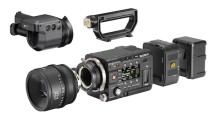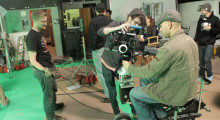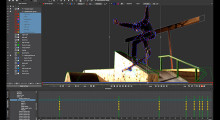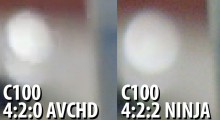Post-Production
Filmmaking - Post-Production
-
Back to the Future with 4K: Large-Sensor Motion Picture Cameras in 2013

A motion picture camera used to be a light-sealed box with a strip of film running through it. Was it easy to thread? Did it run quiet? How bright was the viewfinder? Today’s cameras are exponentially more complex. They are literal bundles of separate technologies, each lurching forward at a different rate. To understand today’s cameras, you must understand the parts to understand the whole. This is my third annual overview of digital cinema cameras for Filmmaker, and it is being written in the run-up to NAB 2013 in Las Vegas, the world’s largest trade show devoted to digital video […]
-
Hero Punk: A Cyberpunk Superhero Film Shot on the Blackmagic Cinema Camera in Green Screen

Kanen Flowers describes himself as a “former technology guy” who got into filmmaking around 2001 with the goal of writing and directing his own material. In 2007, he started work on Jack Forgotten, a project that he says is still in postproduction. Other projects have met with greater success; he started the That Post Show podcast, and a show called That Media Show, and has produced a variety of shorts and web-based content through his production company, Scruffy.tv. At the moment he’s working on Hero Punk, a full-length feature which was shot using the Blackmagic Cinema Camera. Hero Punk is […]
-
Color Grading A Glimpse Inside the Mind of Charles Swan III, Part 2: Chris Martin on the Art of the Post-Grade

In this second part on the color grading of the movie A Glimpse Inside the Mind of Charles Swan III, Chris Martin of SPY describes his work to complete the final grade, the workflow, and the color look of the picture. Chris is a senior colorist at SPY, a post house in San Francisco that does both commercial and narrative feature work. SPY is a visual effects house, but they also have their own DI theater. SPY has been owned by FotoKem since 2009. The first half of the grading process is described in: Color Grading A Glimpse Inside the […]
-
Color Grading A Glimpse Inside the Mind of Charles Swan III, Part 1: Ryan Bozajian on the Art of the Pre-Grade

Like most motion pictures, Roman Coppola’s latest film, A Glimpse Inside the Mind of Charles Swan III was color graded in a DI theater at a post house. Unlike many films, this final grading only took two days; extensive “pre-grading” was done using Resolve Lite at American Zoetrope’s own facilities, while the final grade was performed at SPY using the full version of Resolve. With color grading taking place in two facilities and by two people, the facilities had to work together to calibrate equipment and create a consistent workflow. In part 1 of this series, VFX artist Ryan Bozajian […]
-
Sony Responds to RED, Blackmagic Fix and Avid Continues to Decline

Two weeks ago RED announced that they were suing Sony for patent infringement for technology used in Sony’s PMW-F5, PMW-F55, and F65 cameras. Last week Sony posted a response on their Pro video website. First noting that the F65 has been commercially available for over a year, and that the F5/F55 were announced in October, they go on to say: Sony has now had an opportunity to study Red’s complaint and the asserted patents, and categorically denies Red’s allegations. Sony intends to defend itself vigorously in the Red lawsuit. Sony looks forward to prevailing in court, thus vindicating the Sony […]
-
Cutting for Story: Editor Andrew Weisblum in Conversation

Thelma Schoonmaker and Martin Scorsese. Walter Murch and Francis Ford Coppola. Tim Squyres and Ang Lee. For many an editor, these longtime creative partnerships represent the most alluring and elusive of career ideals. For editor Andrew Weisblum, that ideal is well on the way to becoming a reality — twice over. Since 2007, Weisblum has cut all of both Wes Anderson’s and Darren Aronofsky’s feature films, ranging in style from the witty charm of Fantastic Mr. Fox to the demented psychodrama of Black Swan (for which Weisblum was Oscar nominated). Kicking off this year’s Manhattan Edit Workshop series “Inside the […]
-
Making HENRi: A Low-Budget Sci-fi Short Film Odyssey

A little over three years ago, I decided I wanted to make a sci-fi short film about a robot trying to become human. My idea was to combine live action with miniatures and rod-puppetry – despite having no previous experience with special effects. Initial reactions from family, friends, and collaborators were of the “Are you insane?” variety – perhaps rightfully so. It was at that point I knew I had to make the film. What followed was an odd combination of luck, coincidence, and disaster – three ingredients that are rarely talked about, yet I’m convinced are completely inseparable from […]
-
The Oscars Honors Imagineer Systems’ Mocha

This Sunday is the Oscars, and as is tradition, the really interesting awards – for scientific and technical achievements – were made at an event on February 9. This year Imagineer Systems was presented with an award for their product Mocha, and its underlying Planar Tracking technology. The company was recognized for their “proven record of contributing significant value to the post-production process of making motion pictures.” As a planar tracker – rather than a point tracker – Mocha is able to motion track problematic things such as out of focus footage. Motion blur breaks point trackers, but in Mocha you […]
-
The Need for Speed: Tools to Help You Edit Faster

Anyone who’s joined the FCPX bandwagon will tell you one of the main draws is speed (or at least I will). FCPX let’s you do things quicker. But how we interact with the system (and computers in general) has its limitations. For years the standard of working with NLEs has been left fingers planted on J, K, L, right hand on mouse. It’s not a terribly bad way to edit. Doing it for years you build up a fast muscle memory, but there are still keyboard tasks that stretch the limit of what you can remember, along with the span […]
-
Canon C100 Does 4:2:2 with the Ninja Video Recorder

In yesterday’s article “Canon C100 or C300: Which One to Get?” I wrote about the ability to attach an external recorder to the C100 and record 4:2:2 video, but added: Is 4:2:2 out of the C100 exactly the same as 4:2:2 from the C300? That’s a question I haven’t yet seen a definitive answer to, though a lot of people are assuming it is, or it’s very close. Today, I’m at least a step closer to answering that question. Paul Antico of Anticipate Media, and host of the NeedCreative Podcast, sent me some sample frames taken from Atomos Ninja 2 […]
